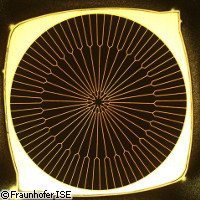Scientists set new record for solar cell efficiency
Researchers at the Germany-based Fraunhofer Institute for Solar Energy Systems (ISE) announced that they have succeeded in improving the efficiency of solar cells, which are designed to convert available light into electricity. The quantum electronic phenomenon called the photovoltaic (PV) effect makes this possible. The team said the effectiveness of III-V semiconductor multi-junction solar cells, used in PV concentrator technology for solar power stations, has been increased by 2.1% to 39.7% - a new European record. The work is funded to the tune of EUR 8.34 million by the EU's Sixth Framework Programme (FP6) project FULLSPECTRUM, under the Thematic area 'Sustainable development, global change and ecosystems'. Project leader Dr Frank Dimroth explained that the team succeeded in improving the contact structures of the solar cells. 'As a result, using the same semiconductor structures, we now achieve the higher efficiency when converting sunlight into electricity,' he said. When light strikes the cell, some of the light is absorbed within the semiconductor material. Essentially, the energy of the absorbed light is transferred to the semiconductor. According to the research team, the optimal efficiency of multi-junction solar cells must be secured between 300 and 600 suns in order to be used in PV concentrator systems. In other words, there must be a sunlight concentration factor of 300-600. The metallisation of the front side of the solar cells yields different concentration factors. 'In the front grid, the current is conducted through a network of thin wires from the middle of the solar cell to the edge' where a 50-micrometre gold wire picks it up, the research team explained. The structure of this metal network is important, they said, adding that this is particularly true when the structure is under concentrated sunlight. The metal wires should have the capacity to transport the sizeable currents produced under concentrated sunlight; low resistance is needed for this to pan out. On the flip side, the wires need to be tiny so as to ensure that the sunlight does not penetrate through the metal. As a result, the metal-covered cell area is not an option when contemplating which element to use in electrical conversion. The Fraunhofer ISE researchers started working on the theoretical calculation of optimal contact structures in 2006. The team succeeded in reaching a solar cells efficiency of 37.6% in July of this year. The Fraunhofer ISE team's findings represent a great step forward in the development of more cost-efficient applications for these types of cells in terrestrial applications. 'We are very pleased to have advanced a further decisive step in such a short amount of time,' remarked Dr Andreas Bett, Department Head at Fraunhofer ISE. 'Highest conversion efficiencies help the young technology to become market competitive and to further sink the costs of generating electricity from the sun for the future.' The research team explained that they have been working on multi-junction solar cells with highest efficiencies for over a decade. However, high material and production costs restrict their use to PV systems and space applications only. FULLSPECTRUM was an integrated project involving 19 European public and industrial research centres seeking a new generation of higher efficiency photovoltaic converters of solar energy into electricity energy. Coordinated by the Technical University of Madrid's Solar Energy Institute in Spain, FULLSPECTRUM ran over a five-year period and ended on 31 October 2008. The project's short-term objectives included the development of multi-junction (MJ) solar cells with very high efficiency, while long-term goals included the evaluation of intermediate band (IB) solar cells as a revolutionary high efficiency concept. According to the researchers, the IB cell is based on the presence of electrons at three energy levels and in the electron pumping with two photons, contrary to two levels and one photon. While no practical high efficiency cells based on this concept have yet to be generated, their experimental results have been fruitful and researchers the world over are keen to carry out studies on this concept, the project partners said. A key component of FULLSPECTRUM was its cooperative research nature, fuelling research and creating programmes in various countries, including Japan and the US. Europe is a leader in cooperative research, a trend triggered primarily by the need to integrate European scientists. FULLSPECTRUM was chosen as one of the 40 success stories of the 6th Framework Programme.
Countries
Germany



